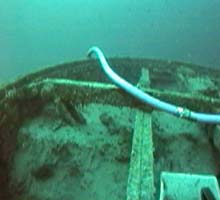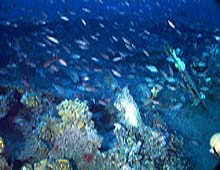
Once the Monitor's turret had been uncovered, as seen here, Navy saturation divers began the task of carefully excavating its contents. Photo courtesy U.S. Navy. Click image for larger view and detailed explanation.

Abundant marine life and coral have made the Monitor wreck home. A thick debris layer, known as Layer B, consists mostly of fragments of dead oculina coral, which sticks together tenaciously and has proven very difficult to remove. Click image for larger view and detailed explanation.
Strenuous Excavation
July 10, 2002
John Broadwater
Sanctuary Manager
Monitor National Marine Sanctuary
Now that the hull and armor belt section have been removed from the top of the turret (see July 5 log), our attention has shifted to the excavation of the turret contents. Soon after sunrise on July 6, “the Bug,” as our remotely-operated vehicle has been nicknamed, was flown over the stern from all angles, giving us our first good look at the exposed turret. Seeing the turret standing free and clear on the seabed was impressive; however, we quickly discovered that the top of the turret was partially obscured by iron deck plates and debris left behind when the hull was lifted away. We also determined that a significant amount of hull framing and plating had yet to be removed to allow us sufficient access around the perimeter of the turret.
When the deck plates were removed from the turret on July 6, we encountered a thick layer of iron fragments, iron concretions, coal and other hull debris. We were able to remove this newly-deposited layer (designated “Layer A”) by July 8, and excavation proceeded into “Layer B”—a foot-thick stratum of compacted silt and dead coral. This layer proved to be slow-going for the divers, who were hoping their dredge would suck out the material in an almost-continuous flow. Unfortunately, the layer consisted mostly of fragments of dead oculina coral, a branching species that sticks together like Legos, thus creating a formidable barrier.
By noon on July 9, most of the turret perimeter had been cleared of hull debris, and about half of the coral layer was out of the turret. Unfortunately, though, the weather began to deteriorate. The wind and seas built out of the southwest throughout the night and through July 10, reaching winds over 30 knots and sea swells of 5 to 7 feet. These difficult conditions were exacerbated by periodic squalls and thunderstorms and by strong bottom currents. By 4 am on the 10th, surface-supplied diving had to be suspended, but saturation diving continued.
At almost midnight today, the troublesome “B Layer" is nearly cleared, and divers on the night shift will begin to excavate "Layer C,” a soft, gray clay that we anticipate will be much easier to remove. Soon, we should encounter the muzzle of one of the Monitor’s 16,000-pound Dahlgren cannons!
Sign up for the Ocean Explorer E-mail Update List.

































